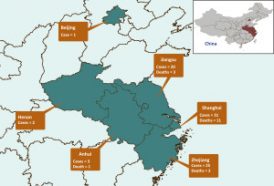Killer-flu update
Infection that recently developed in China shows signs of being easy to spread and hard to kill
By Janet Raloff

The microbes appear able to spread through the air, something not all types of bird-flu germs can do. Even more worrying, the virus appears to be evolving an ability to ignore the drugs meant to kill it. These findings point to a virus with the potential to spread quickly, easily and globally.
The deadly Chinese virus belongs to a new type, or strain. It is one of many that can be spread by birds. Biologists name flu strains using a mix of letters and numbers. The new one belongs to an H7N9 type.
In one new study, scientists from China and North America infected some ferrets with the germ. These animals often serve in flu studies as stand-ins for people. The researchers then put one sick animal along with healthy ferrets in each of several cages. Soon, the healthy ferrets sickened. The researchers reported their findings in the May 23 Science.
One ferret in a neighboring cage of only healthy animals also got the flu. The researchers now suspect it became infected when some sick ferret coughed or sneezed, spewing germs into the air. The good news: Two other neighbor ferrets stayed healthy. So transmitting this flu between mammals does not yet appear to be easy. The bad news: Ferrets began spreading the H7N9 strain before they appeared sick. If the same is true in people, then those who still look fine might be able to infect others.
In a second study, Chinese researchers in Shanghai and Hong Kong analyzed H7N9 samples collected from 14 people, three of whom soon died. All 14 had developed a type of severe lung infection known as pneumonia (nu MOAN ee ah). Each patient had been treated with anti-flu drugs. But in three, the medicine didn’t help.
Doctors often treat people who develop flu with anti-viral drugs. Chief among these: Tamiflu. Such drugs are the only known treatments for H7N9 germs. But the Chinese team found that this virus in three of the sickest people they studied showed a genetic change — or mutation. This allowed the virus to largely ignore the drugs meant to kill it. In one patient, the mutation didn’t develop until after Tamiflu treatment started. The researchers described their disturbing findings May 29 in The Lancet, a medical journal.
Finally, Chinese researchers in Nanjing and Beijing tracked the new germ to poultry. They matched H7N9 germs from one poultry butcher to the virus in birds at a nearby market stall. This woman had been the only person butchering live animals in the entire market. The scientists reported their findings May 22 in the New England Journal of Medicine.
Viruses can mutate quickly. Some may even pick up bits of genes from nearby microbes. The resulting changes may allow germs to morph from a harmless virus into something dangerous. Other times it might convert a disease-causing virus into something harmless.
What most concerns virus experts right now is that the deadly new H7N9 strain might gain an ability to survive for long periods in air or on surfaces. That would increase its chance of staying infectious long enough to spread widely.
Imagine someone sick with the new flu infecting another. Before that second person showed signs of disease, he or she might get on a plane or move throughout a busy market, touching things with virus-tainted hands. In no time, legions of people might become infected and shed the virus ever more widely. This would be hard to halt if the drugs to slow its spread stop working. Indeed, that’s the prescription for a pandemic.
For now, Chinese authorities have closed poultry markets in affected regions. Although that may slow the flu’s spread in people, it does not stop the infection from spreading in wild birds. Indeed, they were probably the initial source of this new virus.
Power Words
epidemic A widespread outbreak of an infectious disease that sickens many people in a community at the same time.
ferret A mammal belonging to the family of animals that includes weasels, skunks, otters and badgers.
generation A set of members of a family regarded as a single group — your parents are one generation, your grandparents another, for example.
microbe Short for microorganism. These are germs too small to be seen by the unaided eye, especially bacteria and viruses.
mutation Some change that occurs to a gene in an organism’s DNA. Some mutations occur naturally. Others can be triggered by outside factors, such as pollution, radiation, medicines or something in the diet.
pandemic An epidemic that affects a large proportion of the population across a country or the world.
pneumonia A lung disease in which infection by a virus or bacterium causes inflammation and tissue damage. Sometimes the lungs fill with fluid or mucus. Symptoms include fever, chills, cough and trouble breathing.
strain (as in microbial) Organisms that belong to the same species that share some small but definable characteristics. For example, biologists breed certain strains of mice that may have a particular susceptibility to disease. Certain bacteria may develop one or more mutations that turn them into a strain that is immune to the ordinarily lethal effect of one or more drugs.







